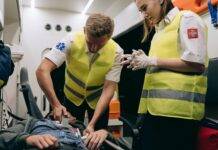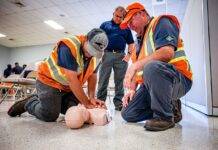
First Aid at Work
Introduction
First aid is an essential skill that everyone should possess, especially in a workplace setting where accidents can occur. It involves providing immediate assistance and care to a person who has been injured or taken ill before professional medical help arrives.
Basics of First Aid
Importance of First Aid
Understanding the significance of administering first aid can make a significant difference in an emergency. It can stabilize a person’s condition, prevent the situation from worsening, and potentially save lives.
Types of Injuries
First aid covers various injuries, including cuts, burns, fractures, choking incidents, and more. Each type requires specific techniques and care.
Steps of First Aid
The fundamental steps of administering first aid involve assessing the situation, providing initial care, and seeking medical help if necessary. Techniques differ based on the injury or illness.
First Aid Kit
Essential Items
A well-stocked first aid kit is crucial in any workplace. It should contain bandages, antiseptic wipes, gloves, scissors, and other necessary items.
Maintenance
Regularly checking and restocking the first aid kit ensures its readiness during emergencies. Expired items should be replaced promptly.
CPR
Procedure
Cardiopulmonary resuscitation (CPR) is a life-saving technique used in emergencies like cardiac arrest. It involves chest compressions and rescue breaths.
Importance
CPR can sustain blood circulation and oxygenation, increasing the chances of survival until professional medical help arrives.
Choking
Signs and Procedures
Recognizing signs of choking and performing the Heimlich maneuver can dislodge the obstructing object and restore normal breathing.
Bleeding
Control and Treatment
Applying pressure and elevating the wound can help control bleeding. Quick action can prevent excessive blood loss.
Fractures
Identification
Recognizing fractures and stabilizing the affected area with splints or support is crucial before medical assistance.
Treatment
Immobilizing the injured area and providing support aids in minimizing further damage and reducing pain.
Burns
Degrees and Treatment
Understanding the severity of burns (first, second, or third degree) determines the appropriate treatment, which may involve cooling the affected area or seeking medical help.
Shock
Symptoms and Response
Recognizing shock symptoms, such as rapid pulse or pale skin, and providing comfort and reassurance while waiting for medical aid is crucial.
First aid at work is vital for handling emergencies and providing immediate care until professional medical help arrives. It involves understanding basic techniques like CPR, wound dressing, treating burns, and managing injuries until emergency services can take over.Conclusion
A workplace equipped with individuals trained in first aid significantly enhances safety. Training and preparedness are vital in effectively managing unforeseen incidents.
FAQs
- How often should first aid kits be checked?It’s recommended to check first aid kits every three months to ensure they are well-stocked and items haven’t expired.
- Should everyone receive first aid training?Absolutely. Basic first aid training should be accessible to everyone, especially in a workplace setting.
- Can I perform CPR without training?While some assistance is better than none, proper CPR training significantly improves the chances of effectively administering it.
- What’s the most important step in providing first aid?Quickly assessing the situation and ensuring your safety before helping the injured person is crucial.
- How can workplaces promote first aid readiness?Encouraging employees to undergo training, conducting drills, and maintaining well-stocked first aid kits are key steps.





















